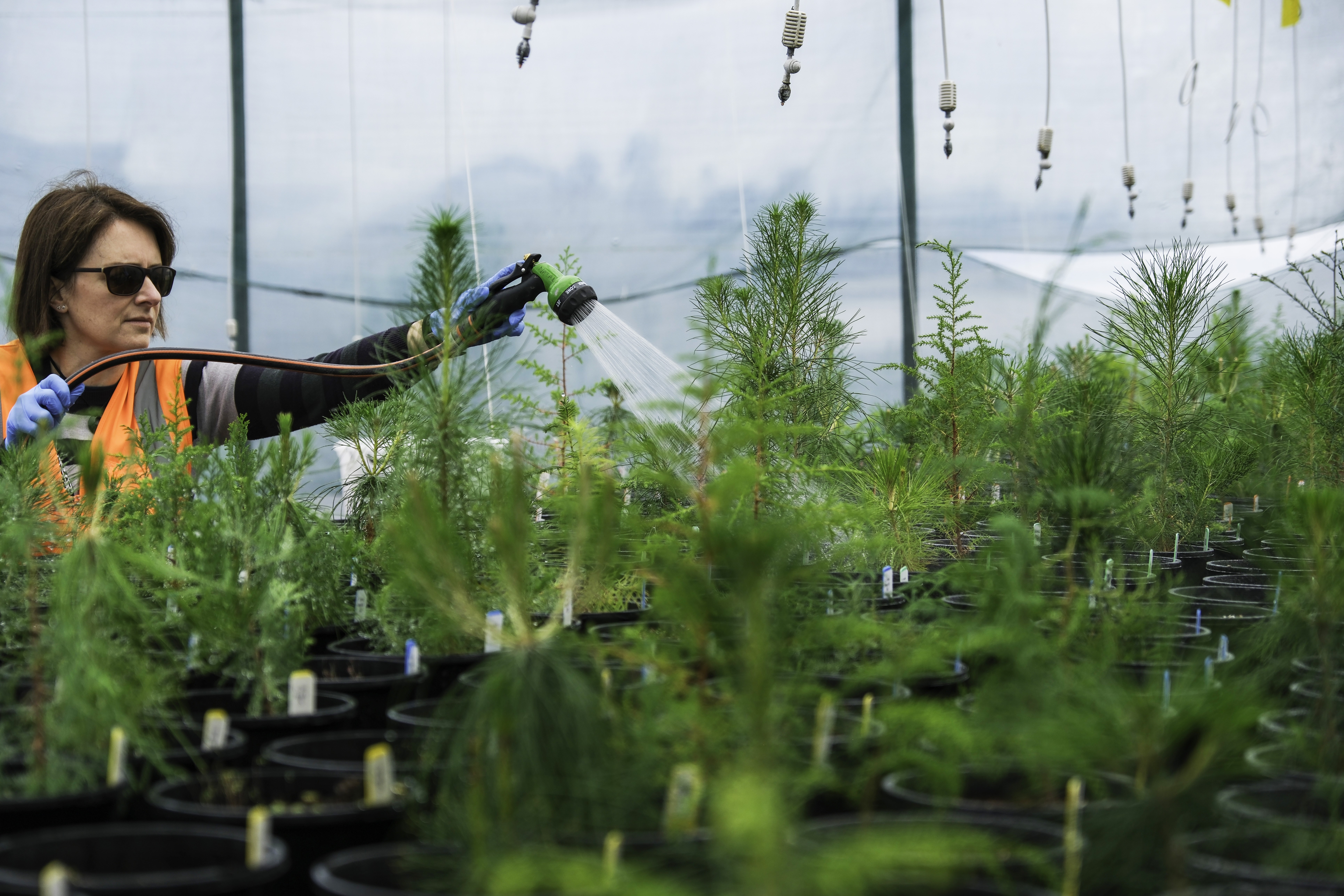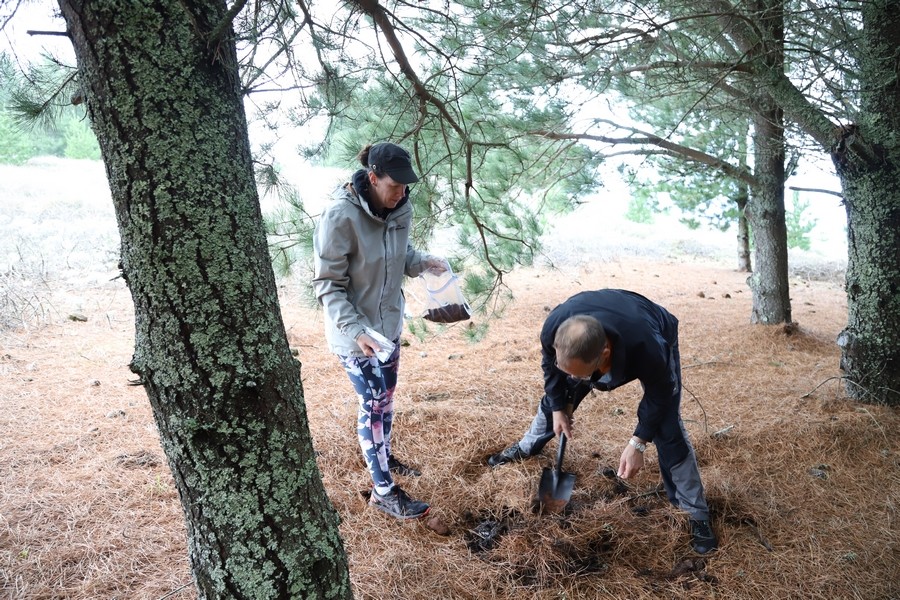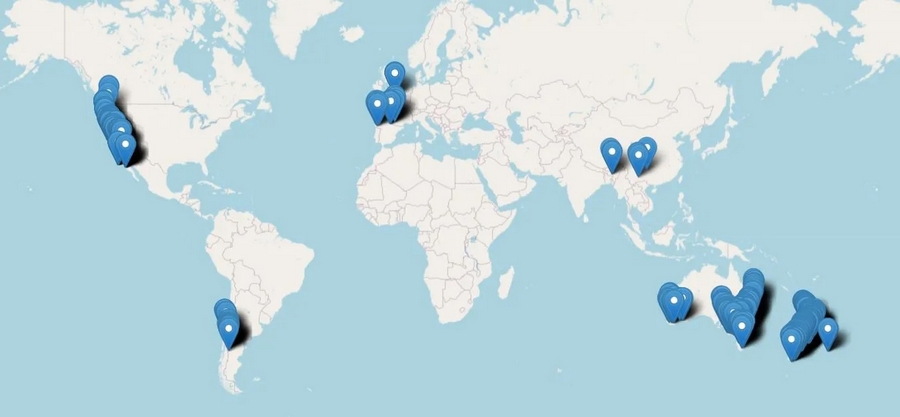Tree Root Microbiome Programme
The five-year Tree Root Microbiome Programme: At the root of climate proofing forests began in 2020 and is an ambitious programme that aims to establish radiata pine as a model system for tree-root-soil microbiome research globally.
Like humans, trees are teeming with a myriad of microorganisms in, on and around them. That community of microorganisms is called a microbiome and it can profoundly affect the tree’s growth, physiology, health and ability to adapt to change.
This research programme aims to build greater understanding of the tree root microbiome, creating new insights and stimulating more research. It answers how trees can continue to grow and be resilient as the climate changes around them.
Long-term, the research could lead to a forest microbiome specifically managed to increase tree productivity and climate change resilience, increase resistance to disease and understand and control tree physiology and wood formation processes.

Background
Forests are one of the ecosystems most sensitive to climate change impacts given they are immobile and typically long-living.
Pinus radiata or Monterey Pine is native to the coast of California and Mexico and is endangered in its native range due to herbivory, diseases, and changing weather patterns. Despite being threatened in its home range, the tree is incredibly successful elsewhere. In fact, it is the most widely planted conifer species globally. It is also fast-growing and has a well-documented genome and established propagation methods which is why it is the focus of this project.
The Tree Root Microbiome Programme looks specifically at root systems because they hold microhabitats with an incredible richness of species. Roots are a key sensor network for trees with a large surface area in contact with the environment. Microbes on and in the roots are profoundly placed to influence how trees sense and respond to environmental cues.
An understanding of how tree-microbiome associations influence tree growth and survival is urgently needed as in many places the climate is changing faster than trees can adapt. Scientists anticipate the tree microbiome could be a huge genetic resource holding the potential to enhance tree health, productivity, and resilience in a changing climate.
To build greater understanding of the tree root microbiome, the research team has sought samples from scientists around the globe. Discovering commonalities and differences between the tree root microbiome in different countries and ecological zones builds knowledge about how best to support pine forests with an optimal microbiome. This is particularly helpful at sites where they are endangered or performing poorly, and where they are performing unexpectedly well.
Ultimately the work could save trees and our forests from the effects of climate change. Learnings from the research programme will also be applicable to New Zealand’s indigenous forests, helping protect all forests from climate change.
About the research
The focus of the programme has been on radiata pine and its microbiome in dry environments including Australia and Southern California. These are places with climatic conditions representing what New Zealand could experience in years to come. Knowledge of the microbiome-tree associations in these environments and how they work together to enable trees to survive periods of environmental stress can be used to protect our future forests. One element of the research has been how the root microbiome influences the resilience of radiata pine to drought.

The research programme is transforming understanding of how trees interact with their environment and each other, opening entirely new opportunities for protecting our productive and natural trees and forests and enhancing climate resilience in forestry practices.
Research areas
There are four main research areas:
- Environmental drivers
- Host drivers
- Characterising the soil environment
- Altering the phenotype
Environmental drivers
This research area aims to understand the critical associations between radiata pine, the microbiome and the environment and build a model of the tree-microbiome associations under a range of environmental situations. It aims to:
- See what we can learn about growing climate-resilient pines in New Zealand by looking at radiata growing in hot and dry climates overseas.
- Examine how the association between the tree, microbiome and environment varies around the world and in extreme climates.
- Understand links between climate factors such as precipitation and temperature on microbiome associations.
- Build a model of the tree-microbiome associations existing in a range of environmental situations and use these to understand links between climate factors. The model will study interactions among tree roots and the microbiome.
- Use the model to future cast climate scenarios for New Zealand and overseas and determine if tree-microbiome associations that will confer resilient traits are present in our soils, or need to be altered or managed.
The international soil sampling work falls under this research area and includes a global research effort with soil sampling from radiata pine around the world. This includes sampling remnant and isolated natural populations of radiata still present in California and Mexico. This may be a valuable reservoir of microbiome diversity that radiata pine outside the native range cannot access.
Soil collections efforts have also included the likes of researchers at Grupo de Ecología y Conservación de Islas (GECI), the Comisión Nacional de Áreas Naturales Protegidas (CONANP), the Universidad Autónoma de Baja California and beyond.
Contact
Host drivers
This research area aims to understand and quantify how genetic differences between radiata pine trees shape the tree root microbiome. It includes:
- How does the host tree genotype (genetic makeup) influence microbiome associations?
- Is the radiata microbiome unique compared with other pine and conifer species and what is the potential for selecting Pinus radiata for elite microbiome associations?
- Is there potential for microbiome characteristics to be inherited during vertical transfer of pollen between plants?
- Do root microbiomes established in nursery planting transfer and survive in the field?
Contact
Characterising the soil environment
This research area aims to understand the role of soil properties in shaping tree root microbiome associations. The work advances our ability to characterise the biogeochemical nature of soils. It involves:
- Adapting new technologies to assess forest soil samples and adopting new techniques to better define the microbiome of soils and connected ecosystems.
- Developing fundamental tools for soil phenotyping and analysis and developing methods for microbiome analysis of the forest floor ecosystem.
- Undertaking high resolution, high through put, low-cost forest soil analysis using mid infra-red spectroscopy.
- New genomic tools for exploration and description of the soil-root microbiome
Contact
Altering the phenotype
This research area looks at how the interaction between microbiome and tree alters the phenotype of the tree to drought tolerance. It explores:
- Measuring the magnitude and significance of the adaptive response.
- Characterising the interactome (molecular interactions in a particular cell) that drives these phenomena.
- Understanding how to help radiata pine adapt to stressful environments with potential for translating these results to other species.
- If root microbiomes that have naturally adapted to drought in the environment can confer ‘ecological memory’ of drought tolerance to a naïve host tree. Explored with partners at the Australian Plant Phenotyping Facility at the University of Adelaide.
- Determining if root microbiomes can be ‘trained’ to be tolerant to drought via exposure to successive water stress limitation. Explored at Lincoln University’s New Zealand Biotron facility.
Contact

Funders and collaborators
The Tree Root Microbiome Programme: At the root of climate proofing forests is supported by the 2020 MBIE Endeavour Fund and the Forest Growers Levy Trust.
New Zealand-based collaborators include:
- Lincoln University
- Victoria University of Wellington.
International collaborators include:
- Hawkesbury Institute for the Environment at the University of Western Sydney
- Wright State University in Ohio
- Woodwell Climate Research Centre in Massachusetts
- Australian Plant Phenomics Network (APPN), University of Adelaide, Australia.
Related links
- Forest Growers Research website
- Tree Root Microbiome research programme underway (Scion)
- Tree Root Microbiome news (Scion)
- Visiting the original home of Pinus radiata (Scion)
- Scientists join forces to unlock secrets of tree survival in a changing climate (Scion)
- Getting to the root of pine challenges (Farmers Weekly)
- Tree scientists quarter the globe to save species (Farmers Weekly)
Publications
Addison, S. L., Rua, M., Smaill, S. J., Singh, B., & Wakelin, S. A. (2024). Partner or perish: tree microbiomes and climate change. Trends in Plant Science vol 29, Issue 9. https://www.scionresearch.com/__data/assets/pdf_file/0016/106171/Trends-in-Plant-Science-Partner-or-perish-paper.pdf
Addison, S. L., Rua, M., Smaill, S. J., Daley, K., Singh, B., & Wakelin, S. A. (2023). Getting to the root of tree soil microbiome sampling. Phytobiomes Journal. https://apsjournals.apsnet.org/doi/10.1094/PBIOMES-09-22-0060-R
Lange, L., Berg, G., Cernava, T., Champomier-Vergès, M. C., Charles, T., Cocolin, L., Cotter, P., D’Hondt, K., Kostic, T., Maguin, E., Makhalanyane, T., Meisner, A., Ryan, M., Kiran, G. S., de Souza, R. S., Sanz, Y., Schloter, M., Smidt, H., Wakelin, S., & Sessitsch, A. (2022). Microbiome ethics, guiding principles for microbiome research, use and knowledge management. Environmental Microbiomes, 17(1), Article 50. https://doi.org/10.1186/s40793-022-00444-y
Sessitsch, A., Wakelin, S. A., Schloter, M., Maguin, E., Cernava, T., Champomier-Verges, M. C., Charles, T. C., Cotter, P. D., Ferrocino, I., Kriaa, A., Lebre, P., Cowan, D., Lange, L., Kiran, S., Markiewicz, L., Meisner, A., Olivares, M., Sarand, I., Schelkle, B., ... Kostic, T. (2023). Microbiome interconnectedness throughout environments with major consequences for healthy people and a healthy planet. Microbiology and molecular biology reviews : MMBR, 87(3), e0021222. https://doi.org/10.1128/mmbr.00212-22
Addison, S., Armstrong, C., Wigley, K., Hartley, R., & Wakelin, S. (2023). What matters most? Assessment of within-canopy factors influencing the needle microbiome of the model conifer, Pinus radiata. Environmental Microbiome, 18(1), Article 45. https://doi.org/10.1186/s40793-023-00507-8
Contact
Dr Steve A. Wakelin, Programme manager
